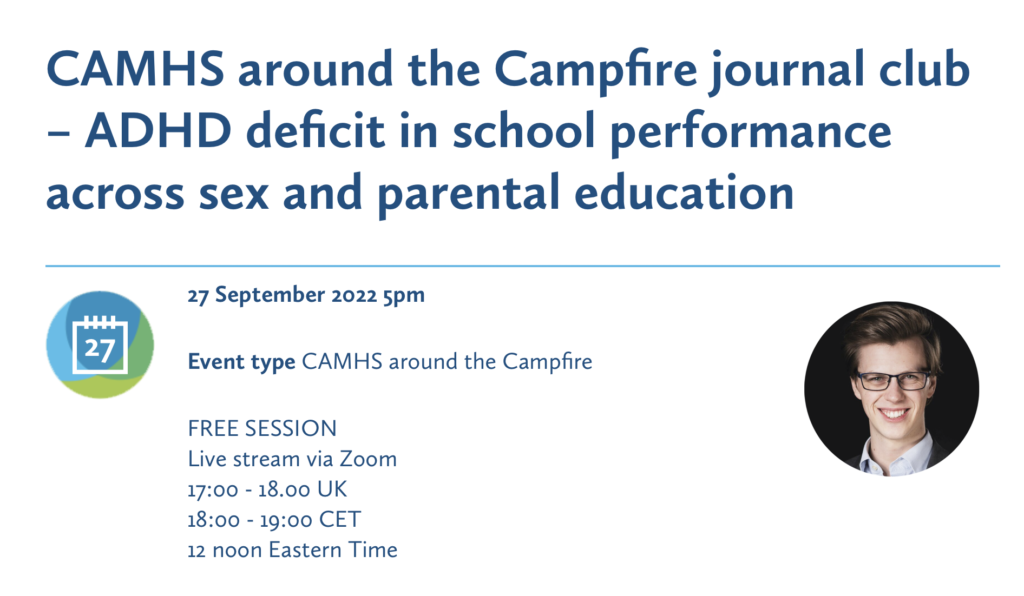
We already know that ADHD is associated with reduced school performance. We also know that other factors affect performance too, such as social circumstances. However, the extent to which these factors interact is not known (Markham, 2022).
This Norwegian population-based cohort study set out to measure how ADHD affects school performance, and explore how it is also affected by sex, family environment and comorbid mental health conditions (Sunde et al, 2022).

ADHD is associated with reduced school performance, but other factors affect performance too, such as social circumstances.
Methods
This research was a registry-based study that included longitudinal data from a whole population.
Population
Everyone born in Norway between 1997 and 2002.
Exposures
ADHD – at least one contact with the primary health care system that included International Classification of Primary Care code P81 (Hyperkinetic disorder), between ages 10 and 16.
Outcomes
Academic performance:
- Grade Point Average (GPA) around age 16 (10th Grade), standardised to z statistics (standard deviations from the mean)
- GPA in different subject areas (e.g. maths, science, sports, music etc)
Other variables:
- Sex
- Parental education – four categories (Masters, BA, High school or Not completed high school)
- Comorbid psychiatric disorders – at least one contact with primary care system coded for psychiatric disorder/s
- Early school performance – standardised test scores from 5th grade.
Early school performance was included to explore whether poor performance comes before ADHD, rather than the other way around.
Results
359,492 Norwegians were eligible. Of these, 344,523 had Grade Point Average (GPA) scores at age 16.
Four percent (13,800 people) had a diagnosis of ADHD according to the study criteria
- ADHD prevalence was higher for boys (5.5%) than girls (2.4%)
- ADHD prevalence was much higher amongst the lower category of parental education status (6.9%) compared with the higher category (1.9%)
Children with ADHD had a Grade Point Average (GPA) -0.86 standard deviations (95% CI: -0.88 to -0.85) lower than children without ADHD:
- Girls were impacted more than boys: -0.99 compared with -0.81
- Sibling analysis found that children with ADHD had, on average, a GPA -0.60 SDs (-0.63 to -0.58) lower than siblings without ADHD
- The effect of ADHD was found to be substantially larger than the effects of comorbid psychiatric diagnoses.
Children of more highly educated parents with ADHD experienced a lesser impact in absolute terms, but greater in relative terms. That is, they did worse compared with other children of highly educated parents, but because the children of highly educated parents do quite well, they still got better grades than children of less educated parents, regardless of whether they had ADHD or not. This shows the impact of growing up with more educated parents.
Theoretical subjects such as maths and science were impacted more than practical subjects (sports, health, music, arts and crafts). However, children with ADHD had lower grades in all school subjects.

Children with ADHD had lower grades in all school subjects, but subjects like maths and science were impacted more than sports, health, music, arts and crafts.
Strengths and limitations
The study included a whole-population sample with good follow-up, high statistical power, and clear, simple binary exposure and outcome measures.
We always need to be mindful of the external validity of exposure measures – what did they actually measure and what are its limitations? In this case, the ADHD assessment did not differentiate type, extent or treatment of ADHD.
The same is true of outcome measures, of course. Although Grade Point Average (GPA) matters in its own right and has good external validity as an educational outcome, we should be mindful of its use as a proxy for cognitive development.
Attrition bias is an important concern for population cohort studies. We know from other similar studies that participants from lower socioeconomic status are more likely to drop out (Launes 2014). In this study, they estimated that children with ADHD were more than four times more likely to fail to register a GPA score than those without ADHD.
However, attrition was small as a proportion of the overall sample. Sensitivity analysis using earlier school performance estimates found similar results, as did their analyses taking account of missing data. It is therefore unlikely that the results are substantially affected by attrition bias (see also Lacey 2013).
Another concern is possible reverse causation (in this case, where poor performance leads to ADHD diagnosis). By adjusting for early school performance, they found some indication that ADHD causes the poor performance rather than the other way around, and is associated with worsening school performance over time.

We always need to be mindful of the external validity of exposure measures – what did they actually measure and what are its limitations?
Conclusions
This is a good quality population registry study that is unlikely to have been affected by bias from selection and attrition. We should always be mindful of how the exposure (ADHD) and outcomes (school performance) were ascertained. This may affect how we interpret the findings.
The results show that, in Norway, ADHD was a substantial risk factor for poor academic performance, independently from other factors.
The relative adverse impact of ADHD was greater for girls, and children of parents with higher education. Nonetheless, the absolute adverse impact of ADHD was greater for boys and children of less educated parents, as they had the lowest school grades.
When interpreting this evidence, we should be cautious about assuming that interventions targeting ADHD in schools will be effective (Ward 2022). A recent systematic review highlighted variation in the findings of trials evaluating school-based intervention, and stressed the importance of contextual factors in implementing them successfully (Moore 2019).

These results show that, in Norway, ADHD was a substantial risk factor for poor academic performance, independently from other factors.
#CAMHScampfire
Join us around the campfire to discuss this paper
The elves are organising an online journal club to discuss this paper with the author Hans Fredrik Sunde, an independent clinical expert Max Davie, a young person with lived experience, and our good friends at ACAMH (the Association of Child and Adolescent Mental Health). We will discuss the research and its implications. The webinar will be facilitated by André Tomlin (@Mental_Elf).
The focus will be on critical appraisal of the research and implications for practice. Primarily targeted at CAMHS practitioners, and researchers, ‘CAMHS around the Campfire’ will be publicly accessible, free to attend, and relevant to a wider audience.
It’s taking place at 5-6pm BST on Tuesday 27th September and you can sign up for free on the ACAMH website or follow the conversation at #CAMHScampfire. See you there!
Links
Primary reference
Sunde HF, Kleppestø TH et al. (2022) The ADHD deficit in school performance across sex and parental education: A prospective sibling‐comparison register study of 344,152 Norwegian adolescents. JCPP Advances 2022 2;2:e12064.
Other references
Gliklich RE, Dreyer NA, eds. Registries for Evaluating Patient Outcomes: A User’s Guide. 2nd ed. (Prepared by Outcome DEcIDE Center [Outcome Sciences, Inc. d/b/a Outcome] under Contract No. HHSA29020050035I TO3.) AHRQ Publication No.10-EHC049. Rockville, MD: Agency for Healthcare Research and Quality. September 2010.
Lacey RJ, Jordan KP, Croft PR. Does attrition during follow-up of a population cohort study inevitably lead to biased estimates of health status? .PLoS One. 2013 Dec 30;8(12):e83948. doi: 10.1371/journal.pone.0083948. eCollection 2013.
Launes J, Hokkanen L et al. Attrition in a 30-year follow-up of a perinatal birth risk cohort: factors change with age.PeerJ. 2014 Jul 8;2:e480. doi: 10.7717/peerj.480. eCollection 2014.
Markham WA, Spencer N. Factors that mediate the relationships between household socio-economic status and childhood Attention Deficit Hyperactivity Disorder (ADHD) in children and adolescents: A systematic review. PLoS One. 2022 Mar 1;17(3):e0262988. doi: 10.1371/journal.pone.0262988. eCollection 2022.
Moore DA, Richardson M et al. Non-Pharmacological Interventions for ADHD in School Settings: An Overarching Synthesis of Systematic Reviews. J Attention Disorders 2019;23(3):220-33.
Ward RJ, Bristow SJ et al. The Effects of ADHD Teacher Training Programs on Teachers and Pupils: A Systematic Review and Meta-Analysis. J Atten Disord. 2022 Jan;26(2):225-244. doi: 10.1177/1087054720972801. Epub 2020 Dec 17. PMID: 33331193; PMCID: PMC8679179.

